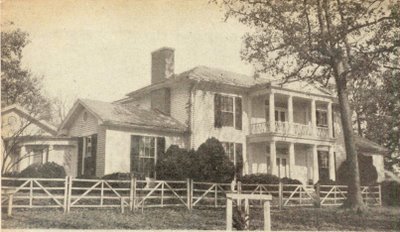
Tennessee Williams
Thomas Lanier Williams was born on March 26, 1911, in Columbus, Mississippi. His father, Cornelius Coffin Williams, was a shoe salesman who spent a great deal of his time away from the family. Williams had one older sister and one younger brother. They spent much of their childhood in the home of their maternal grandfather who was an Episcopal minister. In 1927, Williams got his first taste of literary acclaim when he placed third in a national essay contest sponsored by The Smart Set magazine. The essay was entitled "Can a Good Wife Be a Good Sport?"
In 1939, Williams moved to New Orleans and formally adopted his college nickname "Tennessee" - which was the state of his father's birth. Tennessee Williams, considered one of America's greatest playwrights, drew heavily on his family experiences in his writings. When "The Glass Menagerie" hit Broadway in 1945, it not only changed Tennessee Williams' life, it revolutionized American theater. "A Streetcar Named Desire," "The Night of the Iguana" and "Cat on a Hot Tin Roof" are among his other masterpieces. Among his many awards, Williams won two Pulitzer Prizes and four New York Drama Critics Circle Awards.
In addition to twenty-five full length plays, Williams produced dozens of short plays and screenplays, two novels, a novella, sixty short stories, over one hundred poems, and an autobiography. His works have been translated into at least twenty-seven languages, and countless productions of his work have been staged around the world.
_______________
Okay, you have read this far and undoubtedly have at least wondered why this article on playwright Tennessee Williams has been posted to the Caswell County Historical Association Weblog. What connection could Tennessee Williams possibly have to Caswell County? The CCHA is glad that you asked.
Take a close look at the gravestone fragments shown below. Click on the photographs for a larger image, which should allow you to read the gravestone inscription. You must look at several of them to piece together the entire script:















These gravestone pieces not only were found in Caswell County, they were in Yanceyville. Origninally believed to have been on the property of Giles and Gertie Jones (the old Dr. Allen Gunn house property), they were found on the grounds of Clarendon Hall, which is about as down-town Yanceyville as an address can be. Here is a photograph of Clarendon Hall:

So, what do all these gravestone fragments tell us?
Here is the best guess at the gravestone inscription:
"Sacred To The Memory of Mrs. Sarah Williams wife of the late Robert Williams, Esq. of Pittsylvania County, Virginia, who was born . . . and died in Caswell County, North Carolina October 1814."
These gravestones are from the grave of Sarah Lanier (1748-1814). In 1774, she married Robert Williams (1744-1790). She was born in Lunenburg County, Virginia. He was born in Hanover County, Virginia. Source: Williams Family Website.
His parents were Nathaniel Williams and Elizabeth Washington. His brother was Joseph Williams (1748-1827), who married Rebecca Lanier (1757-1823), sister of Sarah Lanier. And, down through the generations this Joseph Williams was the direct ancestor of playwright Tennessee Williams. Here is the complete ancestral outline:
Joseph Williams m. Rebecca Lanier
John Williams m. Melinda White
John Williams m. Rhoda Campbell Morgan
Thomas Lanier Williams II m. Isabel Coffin
Cornelius Coffin Williams m. Edwina Dakin
Thomas Lanier Williams (better known as Tennessee Williams)
Well, the Caswell County connection to Tennessee Williams is a bit of a stretch. Tennesse Williams is the third great-grand nephew of the husband of the person (Sarah Lanier) who is buried in Yanceyville. At least her gravestone is there.
While not directly connected to Tennessee Williams, the following probably is more relevant for those researching the Williams family of Virginia and North Carolina:
Robert Williams, b. 4 Aug 1744, Hanover Co., Va, d. 1790. Lawyer and as Commonwealth Attorney for Pittsylvania and Henry Counties of Virginia. Married 10 Oct 1774 Orange/Granville Co., NC to Sarah Lanier Williams, b. 12 Dec 1748, Lunenburg Co., Va, d. aft 1804. Sarah Lanier Williams was d/o dau. of Thos. and Eliz. Hicks Lanier, widow of Robert's cousin, Joseph Williams, s/o Daniel Williams and Ursula Henderson. Resided near Sandy Creek of Bannister River, Pittsylvania County, Virginia. According to one source (Fran Laird), Robert and Sarah had five children (names not known at this time). Source: Williams Family Website
There are two Robert Williams' that are uncle and nephew that keep getting confused. The uncle Robert Williams that married to Sarah Lanier died in 1790. He was not the Robert Williams that was the North Carolina Congressman 1797-1803 (and appointed by President Jefferson to be Governor of Mississippi Territory)--this was his nephew, brother of John. See Williams Family Website.
According to The History of Pittsylvania County, Virginia, Maud Carter Clement (1929) at 139:
Robert Williams and his brother Colonel Joseph Williams settled in North Carolina prior to the Revolution, and married sisters, Sarah and Rebecca Lanier, daughters of Thomas Lanier, an early justice of Lunenburg County, who later moved to North Carolina. Sarah Lanier and Robert Williams were married October 10, 1774, and moved to Pittsylvania County to live, settling near Sandy Creek of Banister River. Here he practiced his profession of law and served as commonwealth attorney for both Pittsylvania and Henry Counties. He died in 1790, and the inventory of his estate showed much silver, books, and elegance of living; he left no will but in 1799 there was a division of his estate.
They (Robert Williams and Sarah Lanier Williams) "moved to Pittsylvania County to live, settling near Sandy Creek of Banister River. Here he practiced his profession of law and served as commonwealth attorney for both Pittsylvania and Henry Counties. He died in 1790, . . . ."
Also interesting is the following with respect to the formation of Lunenburg County, Virginia, and the part that Thomas Lanier (father of Sarah Lanier Williams) played in the early days of that county:
The area that today is Pittsylvania County, Virginia, initially was part of a very large county named Brunswick. However, in February 1745 Brunswick County was subdivided to create Lunenburg County, Virginia. A court for the new county was organized and held on 5 May 1745 when eleven gentlemen took the oath of justice of the peace. Thomas Lanier was one of these men.
Thomas Lanier was the son of Nicholas Lanier of Brunswick County, Virginia and grandson of John Lanier, the emigrant, whose will was proven in Prince George County, Virginia 1717, naming sons John, Sampson, Robert, and Nicholas. Thomas Lanier was born about 1722 and married Elizabeth Hicks in 1742, issue: Robert, born 1742; Molly, born 1744; Sarah, born 1748, married first Col. Joseph Williams, second Robert Williams; Betty, born 1750, married Col Joseph Winston; Caty, born 1752; Patsy, born 1754; Rebecca, born 1757, married Col. Joseph Williams, brother of Robert Williams; Thomas, born 1760; Susanna, born 1763; Lewis, born 1765; Fanny, born 1767; William, born 1770. Thomas Lanier moved to Greenville County, North Carolina, where his will was probated August, 1805. (Wheeler's "History of North Carolina").
Source: The History of Pittsylvania County Virginia, Maud Carter Clement (1929) at 48.
And, while all the above is interesting and may delight genealogical researchers, one question remains:
Why was Sarah Lanier Williams buried in Yanceyville, Caswell County, North Carolina?
For more on the ancestry of the Williams and Lanier families go to the Caswell County Family Tree.
THE COMPLETE ANCESTRY of Tennessee Williams
This genealogy links the world-famous playwright to all of his notable cousins, including royalty, presidents of the U.S., and several state governors. Mr. Brayton traces Williams' ancestry back a full 14 generations, citing all primary and secondary sources and sometimes discussing the genealogical problems associated with each ancestor. The volume includes separate chapters on the following Williams ancestors: the two Thomas Bakers of Boston, MA; Bellar of Frederick Co., VA, and Stokes Co., NC; Bowker of King & Queen, Spotsylvania, and Cumberland Cos., VA; Carnes of Boston, MA: Evans of Prince George Co., VA; Lanier of Rowan Co., NC; Miller of Northampton Co., PA; Nickerson of Norfolk, VA; Moses White of Rowan Co., NC; and Woodhouse of Boston, MA.
http://www.genealogical.com/index.php?main_page=product_info&item_number=9919&NLC-GenPointers1




















